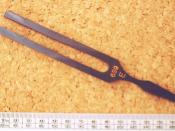Sound
Our tympanic membrane, or eardrum, is just that, a stretched piece of tissue
That receives rythematic pulses known as sound. Sound is actually a linear wave. Think of a stretched out slinky, when you hit one end, a compression travels from one end to the other and back.
Sound is comprised of 2 parts:
Frequency- "pitch" measured in hertz (hz)
Amplitude- "volume" measured in decibels (db)
Think of frequency as a tuning fork, the smaller the tuning fork the faster it vibrates and the higher the pitch. Frequency is measured in Hertz (the number of vibrations per second). Humans are typically sensitive to frequencies between 20 and 20,000 hertz (20hz-20khz). Within that scale of frequency or "pitch" are octaves. Octaves are a certain portion of that scale.
To go to the next octave, you must double in Frequency (ex: 20-40, 40-80, etc). Confused yet? Here's a really simple example:
Do... Re... Me... Fa... So... La... Ti... Do...
That is a full octave, if you can sing in tune. Every time you continue the song, you extend through another full octave. From what I hear, Diana Ross can complete 4 full octaves! Sorry, I'm not even going to try to demonstrate.
Simple enough, huh?
Ok, Lets get to amplitude. Think of a drum, the harder you hit it, the louder it gets. Now, think of that slinky, same thing, the more it moves at one end, the bigger the wave that travels through it. Pretty simple huh? Amplitude or "volume" is measured in decibels (the sound pressure level). Decibels are simply a measurement of how hard that wave is moving.
Measuring it all
Lets say that this graph represents one second of sound.
HThis line hereH represents counting the number of times it vibrated
H H in this case...


